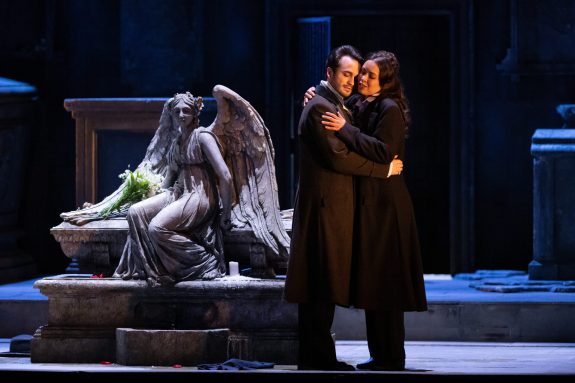 United Kingdom Donizetti, Lucia di Lammermoor: Soloists, Actors, Chorus and Orchestra of the Royal Opera House / Giacomo Sagripanti (conductor). Royal Opera House, Covent Garden. 19.4.2024. (CSa)
United Kingdom Donizetti, Lucia di Lammermoor: Soloists, Actors, Chorus and Orchestra of the Royal Opera House / Giacomo Sagripanti (conductor). Royal Opera House, Covent Garden. 19.4.2024. (CSa)

There are huge challenges to overcome when mounting a full-scale production of a mid-nineteenth century bel canto opera. One such example is Donizetti’s musical reworking of Sir Walter Scott’s gothic romantic novel, The Bride of Lammermoor. Scott’s brutal story, set in the southern borders of a politically divided Scotland before the Act of Union in 1707, makes all those heated Referendum debates and the sinking fortunes of today’s SNP look like a fun-filled cèilidh. It tells of the tragic love between young Lucy (Donizetti’s Lucia) Ashton and her family’s political enemy Edgar (Edgardo) Ravenswood, the cruelty of forced marriage to an approved suitor – Arthur (Arturo) Bucklaw – his gristly murder at Lucy’s hands, and her ensuing madness and death.
Certainly not the least of the two practical problems faced by any creative team staging this opera is first: how best to make an early Grand Guignol melodrama like Lucia di Lammermoor relevant to a modern audience, and second: how to reveal the emotions and psychological dimensions of characters who can come across as dated and wooden. There is also a third difficulty, namely the quite unparalleled technical and musical demands placed by the composer on the singers. All such obstacles are overcome in Katie Mitchell’s 2016 brilliant production of Lucia at Covent Garden, superbly revived by Robin Tebbutt.
Designed by Vicki Mortimer, the sets, subtly lit by Jon Clark, depict the haunted interiors of Lammermoor Castle circa 1835. The stage is divided into two halves so we may follow in one room the narrative as written, and in the other, corresponding events of offstage characters, which are usually consigned to the imagination. Although this ‘split-screen’ approach can momentarily distract attention from the central storyline, Mitchell never allows it to lose the plot, and by providing glimpses into Lucia’s loneliness and inner torment, a rich seam is added to the opera’s psychical tensions. Mitchell’s punchy feminist emphasis – on the victimhood of women in Victorian society – gives us an emotionally battered and abused Lucia, cruelly tricked by her brother Enrico into believing that her true love Edgardo, having made her pregnant, has betrayed her. In a graphically depicted twist to the original plot, a bloody miscarriage provides an additional key to her descent into madness. Nonetheless, once she discovers the truth, she remains spirited and defiant to the bitter end.

The drama of this production certainly held the audience’s attention, but the singing elevated the event into a transformative musical experience. As Lucia, US soprano Nadine Sierra was absolutely outstanding. She possesses a richly textured voice, which combines the dramatic impact and soul-searing vulnerability of Maria Callas with the coloratura dexterity and crystalline precision of Joan Sutherland. Her ability to traverse Donizetti’s vocal embellishments across the entire register, seemingly without appearing to inhale, and her ability to switch smoothly from full operatic volume to the quietest pianissimo was, for want of another word, breathtaking. In the famous mad scene aria, Il dolce Suono, the blood-drenched Lucia is accompanied not by a glass harmonica but by a lone flute obbligato (hauntingly played on this occasion by Katherine Baker). Sierra’s spectral account of Lucia’s mental breakdown at this point held the audience transfixed.
Bel canto tenors have been described as the ‘welterweights’ of the operatic world, and 27-year-old Spanish tenor Xabier Anduaga has already established himself as a world champion. With his diamond-tipped upper register, Anduaga’s flawless messa di voce – his swelling voice modulating from loud to soft and back again in a single sustained gesture – made his Edgardo a credible and tender love match. His final Act III aria Fra poco a me ricovero – in which he pines for refuge in the Ravenswood family crypt – was certainly among the highlights of the evening.
There were excellent performances, too, from the rest of the cast, including oak-toned baritone Artur Ruciński as Lucia’s wicked brother Enrico Ashton, and the stentorian bass Insung Sim as dutiful family chaplain, Raimondo Bidebent. Supported by the wonderfully solid frock-coated Royal Opera Chorus, as well as the impeccable orchestra under the meticulous direction of Giacomo Sagripanti, this production disturbed and thrilled – bringing tragedy and triumph in equal measure.
Chris Sallon
Production:
Director – Katie Mitchell
Revival director – Robin Tebbutt
Designer – Vicki Mortimer
Lighting designer – Jon Clark
Movement director – Joseph Alford
Chorus director – William Spaulding
Cast:
Normanno – Michael Gibson
Enrico Ashton – Artur Ruciński
Lucia – Nadine Sierra
Alisa – Rachael Lloyd
Edgardo – Xabier Anduaga
Raimondo Bidebent – Insung Sim
Arturo Bucklaw – Andrés Presno

We liked it a lot, the opera and script and scenography all was great .
.